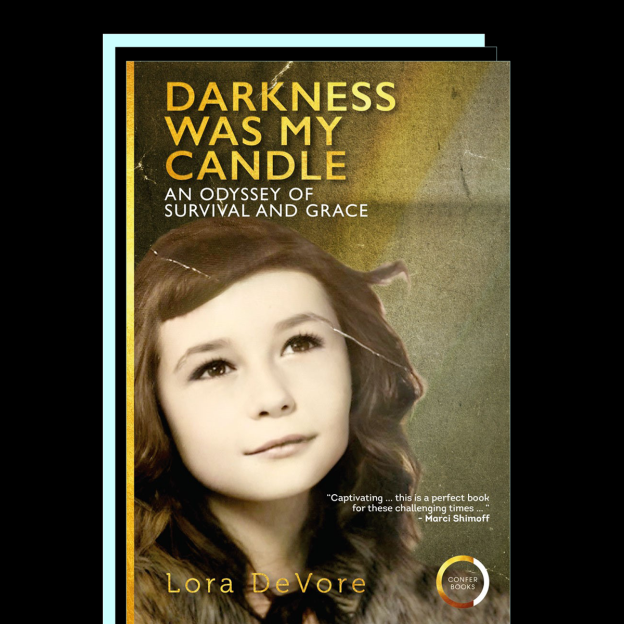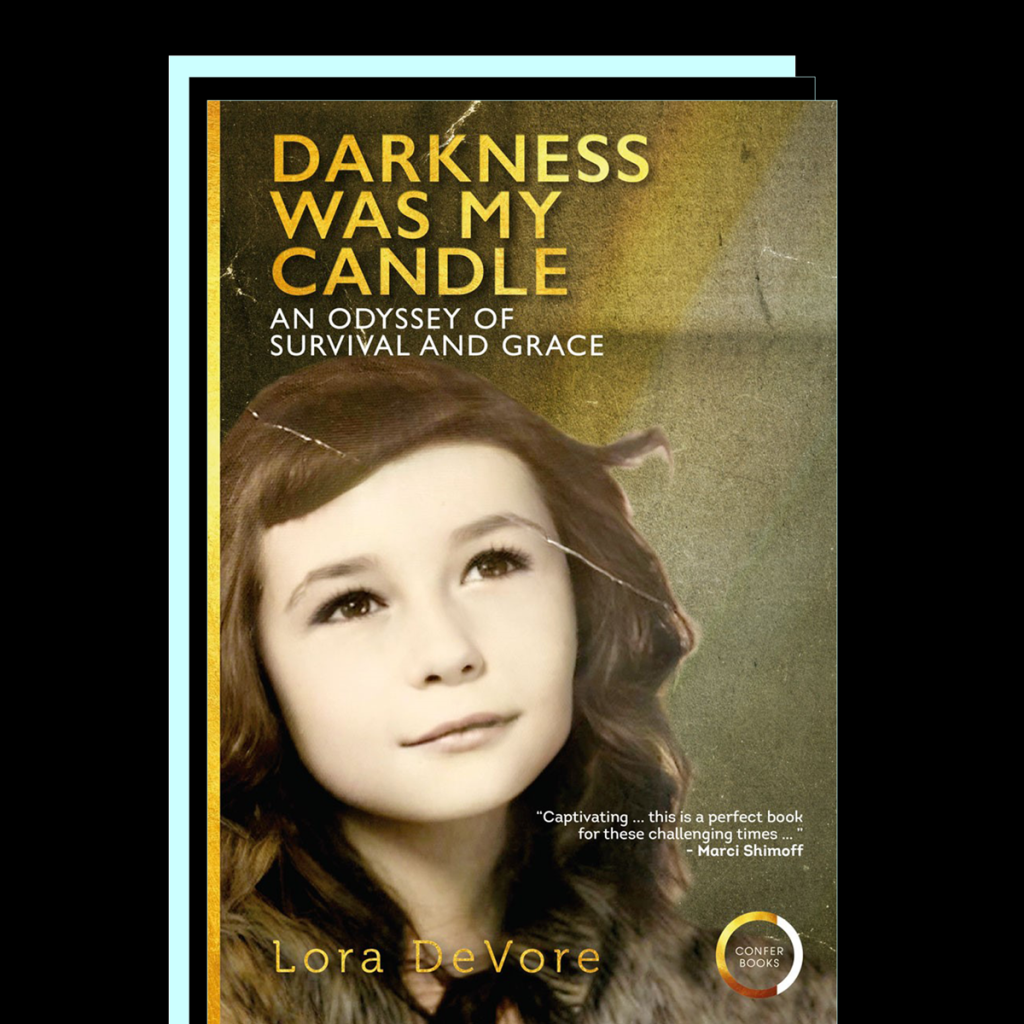
Darkness was my Candle — Lora DeVore
by
“The word psychology once meant ‘study of the soul.’ It comes from the ancient Greek word ‘psyche,’ meaning the mind, soul, or spirit, and ‘logos,’ meaning study.”
– Lora DeVore
Darkness was my Candle is a study of the soul, intertwined with an exposition of the effects trauma and abuse have on the body, mind, and spirit. DeVore writes of the darkness of exploitation, sadness, and longing for safety. Readers follow the destruction of a child’s psychological and somatic development and her long journey through healing from abuse. The language of the book challenges the structural demands that religious and mental health organizations, from DeVore’s experience, often utilize to maintain power over a person. “Perpetrators … always attempt to make sure, by whatever means it takes, that no one listens to the victim” (164). This text, supported by research material and DeVore’s experiences, produces not only a memoir, but a work of trauma-informed literature. Readers are asked to listen and witness the story. The immersion of psychology, the advocacy of listening, and a study of the soul allow healing to take shape on the page.
DeVore recalls the first night with her husband David. She explains, “Past and present merged into that enclosed space and I became confused and terrified of Dave. I began to hyperventilate, and Dave reached out toward me. I hit his hands away and screamed in panic. ‘Get away. Stop looking at me'” (142). The images of recalled trauma linger around the page, and the reader also recalls the detailed memories that lead to this moment of rupture. She employs a narrative technique of folding the past and present into one experience, in effect mimicking dissociation and post-traumatic stress disorder. “It was as though a rubber band had pulled my past and present together and memories stored in my muscles, skin, and optic cortex created a perfect storm of accelerated heart rate, panic, and confusion” (143). DeVore balances awareness and survival as readers begin to understand the effects that abuse has on a person’s mind and body. In crafting the narrative of her life within the same stroke that delineates the reality of PTSD in the mind and body, DeVore destigmatizes the public pressures a victim undergoes in the face of abuse and begins to discharge that culpability. The reader begins to understand what is happening to her emotionally, physically, and spiritually.
Spiritual healing is the catalyst for DeVore’s survival. Symptoms of dissociation and PTSD, which she describes as “the language of my banished and suffering soul” (174) begin to dissipate. In a moment where the author confronts her violent rapist, she finds herself no longer triggered or convinced by his public manipulation. She witnesses his actions and he is unable to sway her sensate reality. This power eventually leads DeVore to witness a spiritual and often magical presence between herself and others. “My traumatic memories were laid down and enclosed within my nervous system and sensate memories, rather than as a narrative. It was not until my sensate memories were recalled and healed that the full story could be constructed” (143).
From the accounts of her early ages, we begin to track DeVore’s growth through moments of cognitive awareness. She narrates the embodiment of trauma through the progressing forms of awareness that pilot the narrative. She talks to us through the horrors, as if a guiding light, gently reminding us that she survived. As readers, we linger in the space between mind and body—both separate from and intertwined within the story. This space between mind and body becomes a refuge as a space that is unviolated, where one can witness and not be enveloped by the effects of certain experiences. We learn that this space is where the inexplicable spirit lingers—where magical things occur.
Psychiatric and psychological services routinely eliminate discussions of the spirit. Traditional practitioners subtly define parameters of what can be talked about and what can be paid attention to. … I invite you to entertain the possibility that we are spiritual beings. An individual’s spiritual reality cannot be organized or classified (186).
It is in this psychosomatic disruption that makes spiritual healing possible for the speaker, and visible to the reader.
“A pattern, an undersong of mystery’s signature, has woven its way through my life like an underground river, influencing its landscape and geography” (185). The undersong of DeVore’s story always reminds us to “trust in the living”—the trees, the love between people, and the commitment to overcome hardship. I am happy to notify you that the text allows readers to witness the speaker’s journey of healing. There is a sudden change in attention: the writer directs our gaze inward to the source of her healing and recovery. The book is always balanced with an exploration of the world around and within.
At the beginning of the book, DeVore shares a moment where she remembers that trees exist, after watching one outside of the barbed windows in Elgin State Hospital. “The Thorazine-drugged, rusty, and worn hinges in my brain opened to the wonder of this tree” (15). She says, “seeing it gave me a tiny dose of hope in living things” (18). This hope in living things is a thread that strung together mind and body, keeping her alive—and eventually leading to her commitment to healing, and work, in the service of others.
This narrative changed the way I understand embodiment: it is multidimensional, and cannot be holistically accounted for without all three aspects of existence—mind, body, and spirit. There is no longer the duality of mind-body that informs awareness, but the third element, soul, that provides a dynamic view of the “body” in literary narratives. The criminality and secrets of abuse and exploitation lose their power as manipulative agents for the destruction of that body as if rising to the surface in order to be witnessed and healed. “Just as the dark was such a revelation, so it turned out was the constant coexistence of light” (4).
VALERIE VARGAS reviewer
Valerie Virginia Vargas is a Venezuelan American poet and printmaker from South Florida. Her work explores womanhood and her relationship to ecology, which manifests through fables and folklore, housework, desire, and magic. She is concerned with the boundaries between form and content, aesthetic and style, art and poetry. Some of her writings can be found in Jellyfish Magazine.

DeVore, Lora. Darkness was my Candle: An Odyssey of Survival and Grace. Confer Books, 2022.
© Copyright for all texts published in Stillpoint Magazine are held by the authors thereof, and for all visual artworks by the visual artists thereof, effective from the year of publication. Stillpoint Magazine holds copyright to all additional images, branding, design and supplementary texts across stillpointmag.org as well as in additional social media profiles, digital platforms and print materials. All rights reserved.